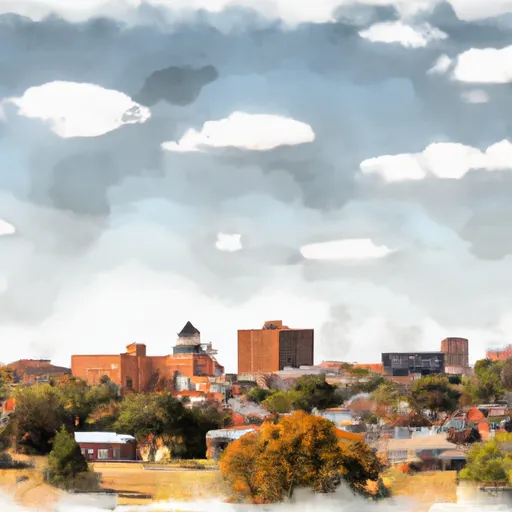-
 Snoflo Premium
Snoflo Premium
Get unlimited access to all our content
With no Ad interruptions! - Start Your Free Trial Login with existing account
Stillwater
Eden Index
Climate
8.3
•
Recreation
3.7
•
Community
2.6
•
Safeguard
5.2/10

Stillwater, Oklahoma is a charming city located in the heart of Payne County. The climate in Stillwater is classified as humid subtropical, with hot summers and relatively mild winters. Summers are typically hot and humid, with temperatures averaging around 90°F (32°C), while winters are cool, with temperatures averaging around 40°F (4°C). The area receives an average of 35 inches of rainfall annually, with May being the wettest month.
Hydrologically, Stillwater is situated in the Lower Cimarron River Watershed, which is part of the Arkansas-Red-White River Basin. The city relies on surface water from Lake Carl Blackwell and groundwater from wells for its water supply.
Outdoor recreation opportunities in Stillwater are abundant. Lake Carl Blackwell is a popular destination for boating, fishing, and swimming. The lake offers numerous picnic areas, campgrounds, and nature trails for visitors to enjoy. Stillwater also boasts several parks and recreational areas with sports fields, playgrounds, and walking trails. The area is also renowned for its golf courses, providing opportunities for golf enthusiasts.
In conclusion, Stillwater, Oklahoma offers a diverse climate, with outdoor recreation opportunities centered around its beautiful lake, parks, and golf courses.
What is the Eden Index?
The Snoflo Eden Index serves as a comprehensive rating system for regions, evaluating their desirability through a holistic assessment of climate health, outdoor recreation opportunities, and natural disaster risk, acknowledging the profound impact of these factors on livability and well-being.
Climate Health Indicator (CHI): 8.3
Stillwater receives approximately
925mm of rain per year,
with humidity levels near 81%
and air temperatures averaging around
16°C.
Stillwater has a plant hardyness factor of
7, meaning
plants and agriculture in this region tend to thrive during the non-winter months.
By considering the ideal temperature range, reliable water supplies, clean air, and stable seasonal rain or snowpacks, the Climate Health Indicator (CHI) underscores the significance of a healthy climate as the foundation for quality living.
A healthy climate is paramount for ensuring a high quality of life and livability in a region, fostering both physical well-being and environmental harmony. This can be characterized by ideal temperatures, reliable access to water supplies, clean air, and consistent seasonal rain or snowpacks.
Weather Forecast
Streamflow Conditions
Lower Cimarron
Area Rivers
Lower Cimarron
Snowpack Depths
Lower Cimarron
Reservoir Storage Capacity
Lower Cimarron
Groundwater Levels
Recreational Opportunity Index (ROI): 3.7
The Recreational Opportunity Index (ROI) recognizes the value of outdoor recreational options, such as parks, hiking trails, camping sites, and fishing spots, while acknowledging that climate plays a pivotal role in ensuring the comfort and consistency of these experiences.
Access to outdoor recreational opportunities, encompassing activities such as parks, hiking, camping, and fishing, is crucial for overall well-being, and the climate plays a pivotal role in enabling and enhancing these experiences, ensuring that individuals can engage in nature-based activities comfortably and consistently.
Camping Areas
| Campground | Campsites | Reservations | Toilets | Showers | Elevation |
|---|---|---|---|---|---|
| The Point - Chickasaw National Rec Area | None | 937 ft | |||
| Central - Chickasaw National Rec Area | 10 | 961 ft | |||
| R.C. Longmire Lake | None | 1,002 ft | |||
| Rock Creek - Chickasaw National Rec Area | 106 | 959 ft | |||
| Buckhorn - Chickasaw National Rec Area | 134 | 930 ft | |||
| Pauls Valley City Lake | 28 | 910 ft | |||
| Turner Falls Park | 500 | 960 ft | |||
| Mountain Lake | None | 1,002 ft | |||
| Cold Springs - Chickasaw National Rec Area | 65 | 984 ft | |||
| Guy Sandy - Chickasaw National Rec Area | None | 1,015 ft |
Catastrophe Safeguard Index (CSI):
The Catastrophe Safeguard Index (CSI) recognizes that natural disaster risk, encompassing floods, fires, hurricanes, and tornadoes, can drastically affect safety and the overall appeal of an area.
The level of natural disaster risk in a region significantly affects safety and the overall livability, with climate change amplifying these risks by potentially increasing the frequency and intensity of events like floods, fires, hurricanes, and tornadoes, thereby posing substantial challenges to community resilience and well-being.
Community Resilience Indicator (CRI): 2.6
The Community Resilience Indicator (CRI) recognizes that education, healthcare, and socioeconomics are crucial to the well-being of a region. The CRI acknowledges the profound impact of these elements on residents' overall quality of life. By evaluating educational resources, healthcare accessibility, and economic inclusivity, the index captures the essential aspects that contribute to a thriving community, fostering resident satisfaction, equity, and social cohesion.

